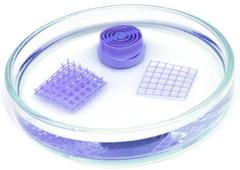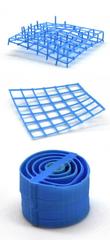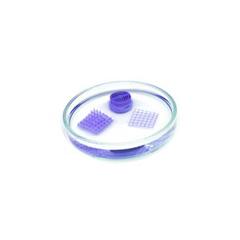URL: https://www.desy.de/news/news_search/index_eng.html
Breadcrumb Navigation
DESY News: Scientists develop printable water sensor
News
News from the DESY research centre
Scientists develop printable water sensor
A new, versatile plastic-composite sensor can detect tiny amounts of water. The 3d printable material, developed by a Spanish-Israeli team of scientists, is cheap, flexible and non-toxic and changes its colour from purple to blue in wet conditions. The researchers lead by Pilar Amo-Ochoa from the Autonomous University of Madrid (UAM) used DESY’s X-ray light source PETRA III to understand the structural changes within the material that are triggered by water and lead to the observed colour change. The development opens the door to the generation of a family of new 3D printable functional materials, as the scientists write in the journal Advanced Functional Materials (early online view).

The functional part of the scientists’ new sensor-material is a so-called copper-based coordination polymer, a compound with a water molecule bound to a central copper atom. “On heating the compound to 60 degrees Celsius, it changes colour from blue to purple”, reports Pilar Amo-Ochoa. “This change can be reversed by leaving it in air, putting it in water, or putting it in a solvent with trace amounts of water in it.” Using high-energy X-rays from DESY's research light source PETRA III at the experimental station P02.1, the scientists were able to see that in the sample heated to 60 degrees Celsius, the water molecule bound to the copper atoms had been removed. This leads to a reversible structural reorganisation of the material, which is the cause of the colour change.

The sensor material can be printed in various forms. The workpieces shown are each about one centimeter wide. In the presence of water, for example from the air humidity, it turns blue. Credit: UAM, Verónica García Vegas
If it is dried, either in a water free solvent or by heating, the material turns back to purple. A detailed investigation showed that the material is stable even over many heating cycles, and the copper compounds are evenly distributed throughout the printed sensors. Also, the material is stable in air over at least one year and also at biological relevant pH ranges from 5 to 7. “Furthermore, the highly versatile nature of modern 3D printing means that these devices could be used in a huge range of different places,” emphasises co-author Shlomo Magdassi from The Hebrew University of Jerusalem. He adds that the concept could be used to develop other functional materials as well.
“This work shows the first 3D printed composite objects created from a non-porous coordination polymer,” says co-author Félix Zamora from the Autonomous University of Madrid. “It opens the door to the use of this large family of compounds that are easy to synthesize and exhibit interesting magnetic, conductive and optical properties, in the field of functional 3D printing.”
The Autonomous University of Madrid, the Hebrew University of Jerusalem, the Nanyang Technological University in Singapore, the Institute for Materials Science in Madrid and DESY contributed to this research.
Reference:
3D printing of a thermo- and solvato-chromic composite material based on a Cu(II)- thymine coordination polymer with moisture sensing capabilities; Noelia Maldonado, Verónica G. Vegas, Oded Halevi, Jose Ignacio Martinez, Pooi See Lee Shlomo Magdassi, Michael T. Wharmby, Ana E. Platero-Prats, Consuelo Moreno, Félix Zamora and Pilar Amo-Ochoa; Advanced Functional Materials, 2019; DOI: 10.1002/adfm.201808424





